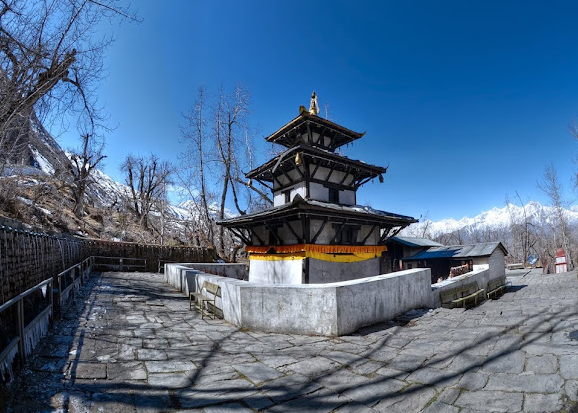The history of Muktinath Temple in Nepal dates back to the 19th century. It is believed that Queen Sabarna Prabha of Nepal initiated the construction of this sacred Vishnu temple. The temple is thought to have been built by Hindus. In 1818, the renowned Tibetan yogi Shabkar visited the Muktinath Temple and stayed for several days to familiarise himself with the place.
According to Tibetan Buddhist tradition, Guru Rinpoche, also known as Padmasambhava, the founder of Tibetan Buddhism, is said to have meditated at Muktinath on his way to Tibet. Damodar Kunda, the main source of Shaligrams and the Gandaki River, is located near Muktinath Temple. In Tibetan, Damodar Kund is known as "Men-Chu" and is closely associated with the life of Guru Rinpoche, marking the beginning of Mukti Kshetra.
Indian mythology describes a great battle between Lord Shiva and Jalandhar, a powerful king of the asuras. Jalandhar, driven by his cunning, attacked Kailash to abduct Parvati, the wife of Lord Shiva. Using his abilities, Jalandhar disguised himself as Shiva, but Parvati, with her spiritual strength, saw through the deception and sought Shiva's help. A fierce battle ensued, but Jalandhar was protected by his wife Vrinda's unwavering loyalty.
The gods then devised a plan to defeat Jalandhar. Lord Vishnu, using his power, transformed into an image of Jalandhar to deceive Vrinda. Unaware of the deception, Vrinda unknowingly abandoned her support for Lord Shiva, allowing Shiva to defeat and kill Jalandhar.
When Vrinda realised the truth, she cursed Lord Vishnu to become a stone (Shila). Lord Vishnu then manifested as the Shaligram in the Muktinath region. After casting the curse, Vrinda immolated herself, and the Tulsi plant arose from her ashes.
Vrinda's devotion greatly impressed Lord Vishnu, and as a result, the Tulsi leaf is considered essential in the worship of Shaligrams.
Puranic Significance :
In Tibetan Buddhist tradition, Muktinath Temple is revered as a site where Guru Rinpoche (Padmasambhava), the founder of Tibetan Buddhism, meditated on his journey to Tibet. The temple is also celebrated in Hindu scriptures, with its importance highlighted in texts such as the Vishnu Purana and the Gandaki Mahatmya. The waterway flowing downstream from Muktinath along the Kali Gandaki River is the source of Shaligrams, sacred stones essential for establishing Vishnu temples. Muktinath is considered one of the holiest pilgrimage sites for both Hindus and Buddhists, featuring 108 water springs, a number with deep significance in Hindu philosophy. Hindu astrology, for instance, combines 12 zodiac signs with 9 planets, resulting in 108 key combinations, while the 27 lunar mansions (Nakshatras) divided into four quarters each also total 108 Padas.
